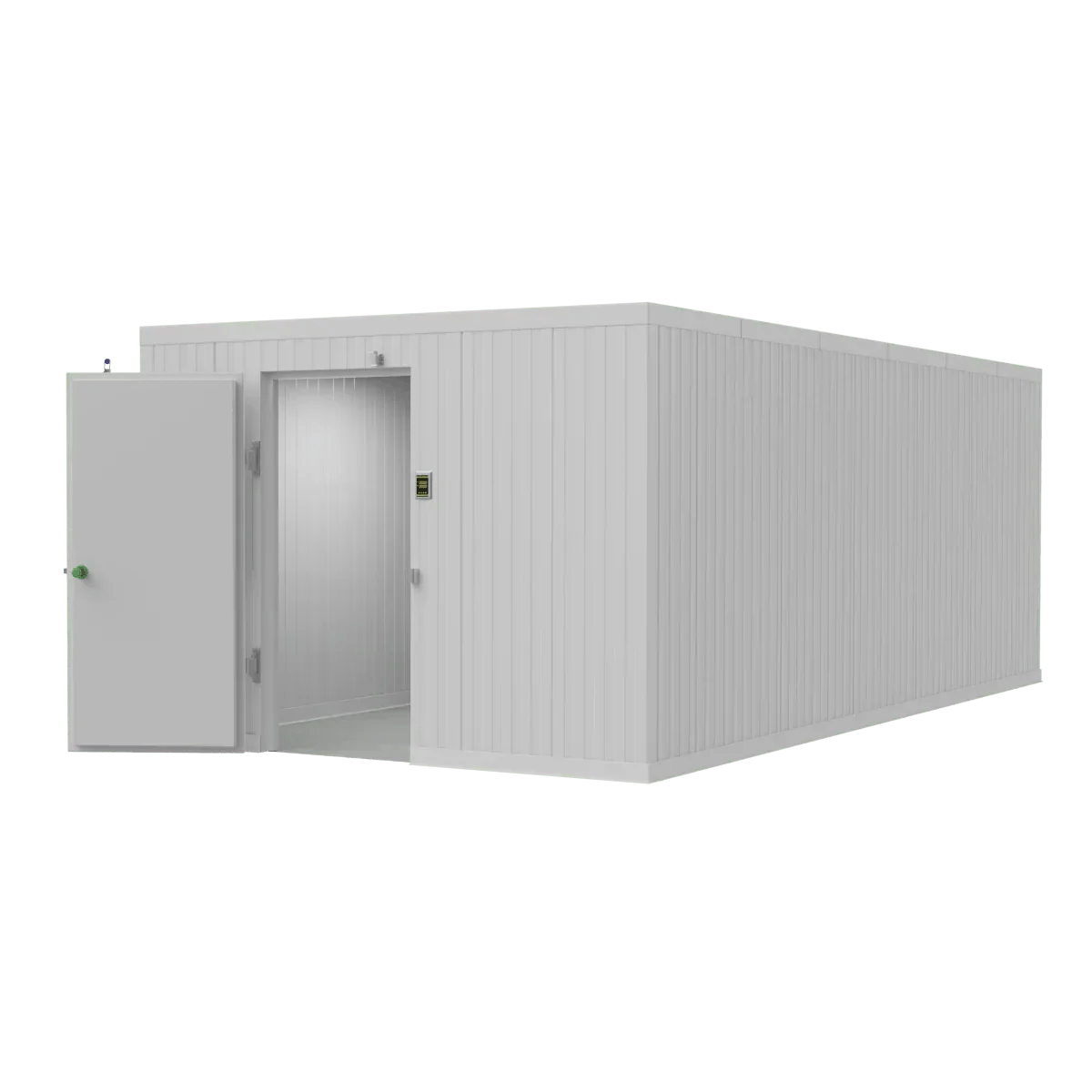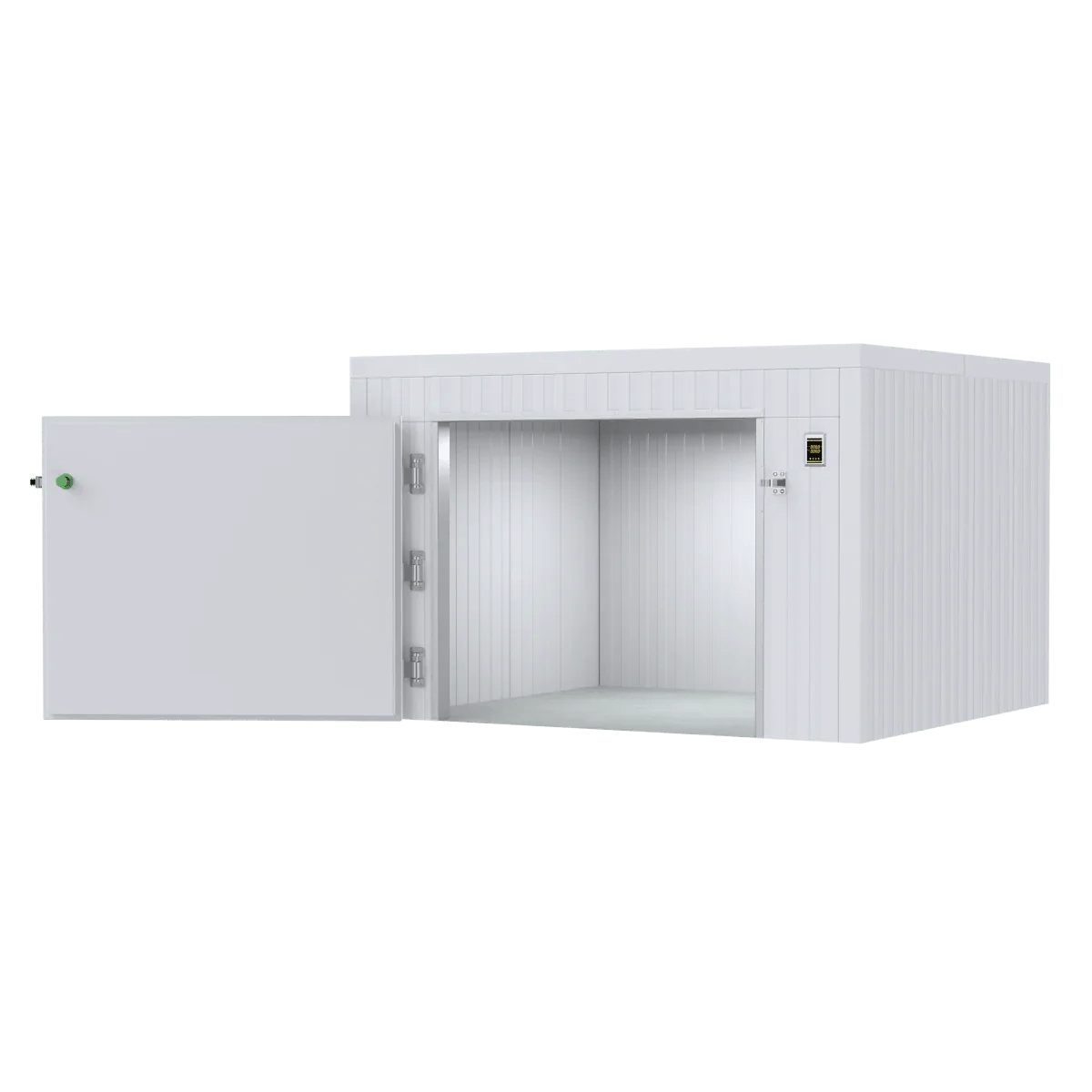Essential Guide to Foldable Stretchers
A foldable stretcher is a portable patient transport device designed to be compacted for storage and expanded when needed for emergency use. If you're looking for quick information about foldable stretchers, here's what you need to know:
| Feature | Description |
|---|---|
| Purpose | Patient transport in emergency and medical settings |
| Key Benefit | Compact storage while maintaining full functionality |
| Weight | Typically 5-16 lbs (2.3-7.3 kg) |
| Load Capacity | Most models support 350-700 lbs (159-318 kg) |
| Materials | Aluminum alloy frame with PVC-coated polyester or canvas bed |
| Common Features | Safety belts, anti-slip handles, rubber feet |
| Folded Size | As small as 41" × 7" × 4" (104 × 17 × 9 cm) |
| Applications | EMS, hospitals, sports venues, disaster response, mortuary services |
When space is at a premium but patient safety can't be compromised, foldable stretchers truly shine. These remarkable devices represent the perfect marriage of functionality and practicality in emergency transport. Unlike their rigid cousins that demand dedicated storage space, these ingenious tools tuck away neatly until the moment they're needed.
Think about the last time you needed something in a hurry – that's exactly when a foldable stretcher proves its worth. With simple unfolding mechanics, they transform from a compact package to a full-sized transport solution in seconds. This quick-deployment design makes them invaluable across countless settings where both immediate response capability and storage efficiency matter.
The magic lies in their thoughtful engineering. Some models fold lengthwise, creating a slim profile that slides easily into ambulance compartments. Others fold width-wise, ideal for storage in tight spaces. Premium options even fold in both directions, collapsing to remarkably compact dimensions while sacrificing nothing in stability or strength.
Don't let their lightweight construction fool you. Built with aircraft-grade aluminum alloy frames, quality foldable stretchers handle impressive loads – standard models easily support patients up to 350 pounds, while specialized designs can safely transport individuals weighing 700 pounds or more. The durability-to-weight ratio is nothing short of impressive.
Their versatility makes them essential across numerous fields. Emergency medical technicians rely on them to steer narrow stairwells in apartment buildings. Athletic trainers keep them courtside for immediate response to sports injuries. Disaster response teams value their portability during evacuation efforts. And funeral directors appreciate their discrete, dignified transport capabilities in challenging environments.
Here at American Mortuary Coolers, we've supplied foldable stretchers to funeral homes nationwide. Our experience has taught us that the right transport equipment combines reliability, ease of use, and proper certification. We take pride in helping funeral professionals select models that meet their specific needs while ensuring compliance with industry standards.
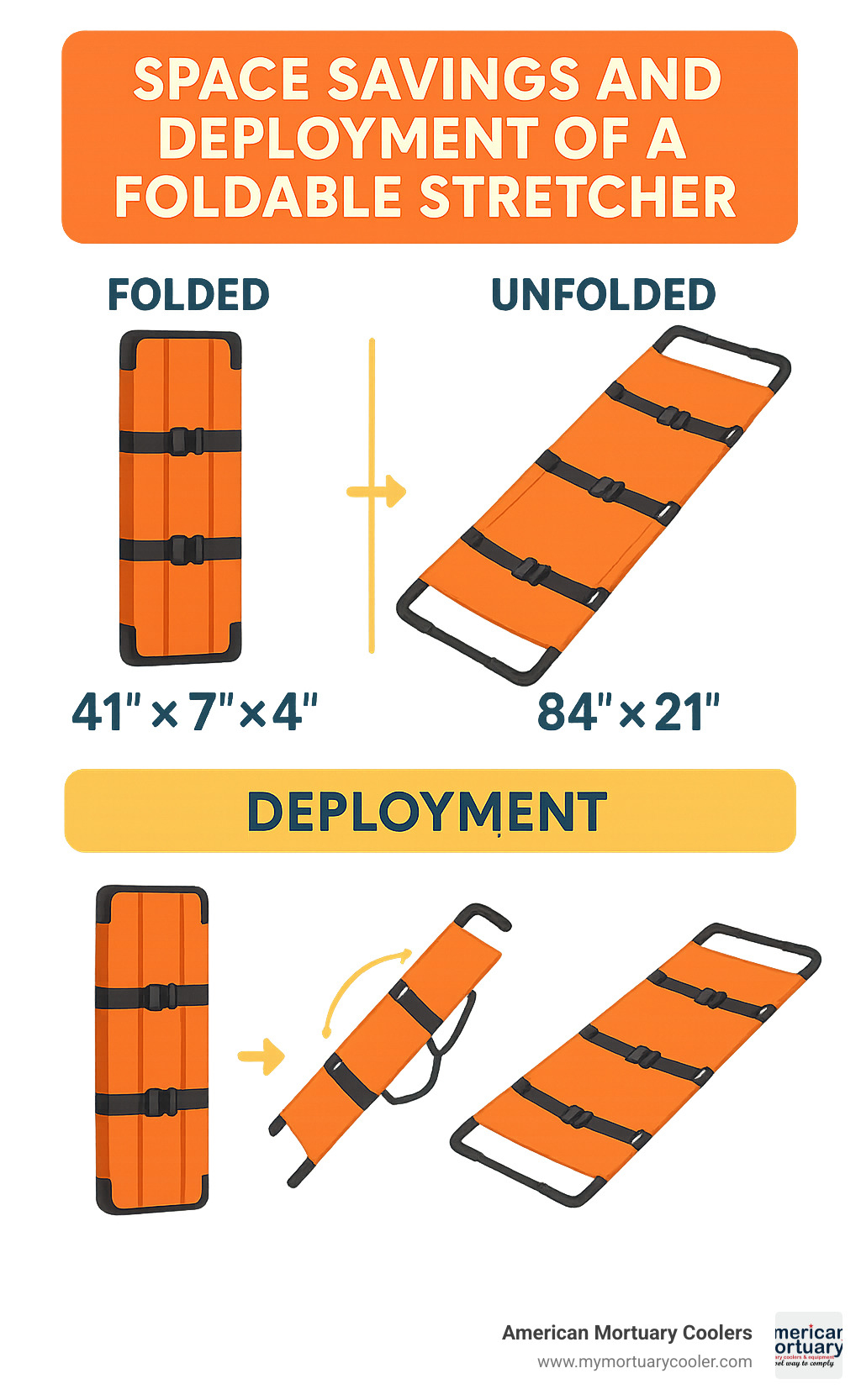
Foldable stretcher word guide:
Understanding Foldable Stretchers: Design, Materials, Safety
When you hear the term foldable stretcher, you might picture a simple portable bed. But these ingenious devices are marvels of practical engineering that save space without sacrificing function. Unlike their rigid cousins that demand permanent storage space, foldable stretchers tuck away neatly when not needed, then spring to action in emergencies.
Think of a foldable stretcher as the Swiss Army knife of patient transport. At its heart lies a sturdy aluminum alloy frame that's both lightweight and remarkably strong. This frame supports a patient surface typically made from tough-as-nails materials like PVC-coated polyester or oxford canvas. These fabrics aren't just strong—they're designed to resist fluids, bacteria, and harsh cleaning chemicals while remaining comfortable for patients during transport.
Safety is never an afterthought with these devices. Every good foldable stretcher comes equipped with patient restraint systems—usually 2-3 safety belts with quick-release buckles that keep patients secure without being restrictive. The carrying handles feature anti-slip grips that stay secure even when wet, while rubber feet prevent the stretcher from sliding around when placed on the ground.
What Sets a Foldable Stretcher Apart?
The magic of a foldable stretcher lies in its versatility. While rigid stretchers certainly have their place, they're like that bulky winter coat that takes up half your closet—necessary but inconvenient. Foldable stretchers solve this problem brilliantly with designs that maintain strength when deployed but collapse down to half their size for storage.
Speed matters in emergencies, and that's another area where these devices shine. A well-designed foldable stretcher can be unpacked and ready for use in under 10 seconds by trained hands. That's often the difference between a smooth operation and precious minutes lost fumbling with equipment.
The folding styles vary widely to suit different needs. Some fold lengthwise like a book, others width-wise like a map, and premium models fold in multiple directions, becoming astonishingly compact. Despite their featherlight frames (often weighing just 5-16 pounds), these stretchers can support patients weighing several times their own weight—a testament to smart engineering and quality materials.
Key Components & Materials
Every foldable stretcher is a symphony of carefully designed parts working together. The side poles, typically made from anodized aluminum, form the backbone of the structure. This anodization process isn't just for looks—it creates a hard, corrosion-resistant surface that stands up to harsh environments and frequent cleaning.
The spreader bars might not get much attention, but they're heroes in their own right. These components maintain the stretcher's width when deployed and often house the folding mechanism itself. They need to be both strong and reliable since they're what prevents unwanted folding during patient transport.
The fabric bed is where comfort meets function. High-strength materials like PVC-coated polyester don't just support weight—they resist tears, repel fluids, fight bacteria, stand up to sunshine, and shrug off harsh cleaning chemicals. This combination makes them perfect for the unpredictable environments where foldable stretchers often find themselves.
Quality finishes make a world of difference in real-world use. Corrosion-resistant coatings protect metal components from rust and degradation. Anti-slip handle coatings ensure secure grips even in less-than-ideal conditions. Many models even include reflective strips that catch light in dark environments, making the stretcher visible during nighttime operations.
For more detailed information about stretcher fundamentals, our guide to medical stretchers offers additional insights.
Built-In Safety Features
When someone's being transported on a foldable stretcher, safety isn't just important—it's everything. That's why manufacturers build in multiple safety systems to protect both patients and operators.
The restraint systems are front-line defenses against patient falls. Most models include 2-3 adjustable safety belts with quick-release buckles that secure patients firmly but comfortably. These prevent unwanted movement during transport while allowing fast release when needed.
The handles might seem simple, but they're carefully designed with nonslip grips that remain secure even when wet with rain, snow, or even bodily fluids. This thoughtful touch ensures operators maintain control in challenging conditions.
Perhaps the most critical safety features are the locking hinges. These mechanisms are the guardians against accidental folding—a catastrophic failure that quality manufacturers design against with positive-lock systems that can't disengage without deliberate action.
Many foldable stretchers also incorporate high-visibility elements like reflective strips that catch headlights or flashlight beams, making the stretcher visible in dark conditions. This visibility can be crucial during nighttime emergency operations or power outages.
When placed on the ground, rubber feet stabilize the stretcher, preventing unwanted movement during the critical moments of patient loading and unloading. This small but thoughtful feature helps create a stable platform when it matters most.
Together, these safety features create a transport system that protects vulnerable patients while giving operators the confidence that their equipment won't let them down when it matters most.
Specs & Standards: Size, Weight, Capacity, Certifications
Shopping for a foldable stretcher can feel a bit like buying a car - there are specs to compare, standards to understand, and features to weigh. Let's break down what really matters when you're looking at the numbers behind these life-saving devices.
The beauty of a foldable stretcher lies in its remarkable balance of lightness and strength. Most weigh between 5-16 pounds - light enough that you can easily carry one with one hand when folded, yet engineered to support a person weighing many times that. It's pretty amazing when you think about it!
Load capacities typically range from 159-350 pounds for standard models, though some specialized designs can support up to 700 pounds. When folded, a quality stretcher can compact down to dimensions as small as 41″×7″×4″ - about the size of a rolled-up sleeping bag. This makes them perfect for tucking into ambulance compartments, emergency cabinets, or anywhere space is at a premium.
To ensure safety and quality, look for these important certifications:
- ISO 13485 (quality management systems for medical devices)
- FDA approval (for US markets)
- CE marking (for European markets)
- GMDN classification (Global Medical Device Nomenclature)
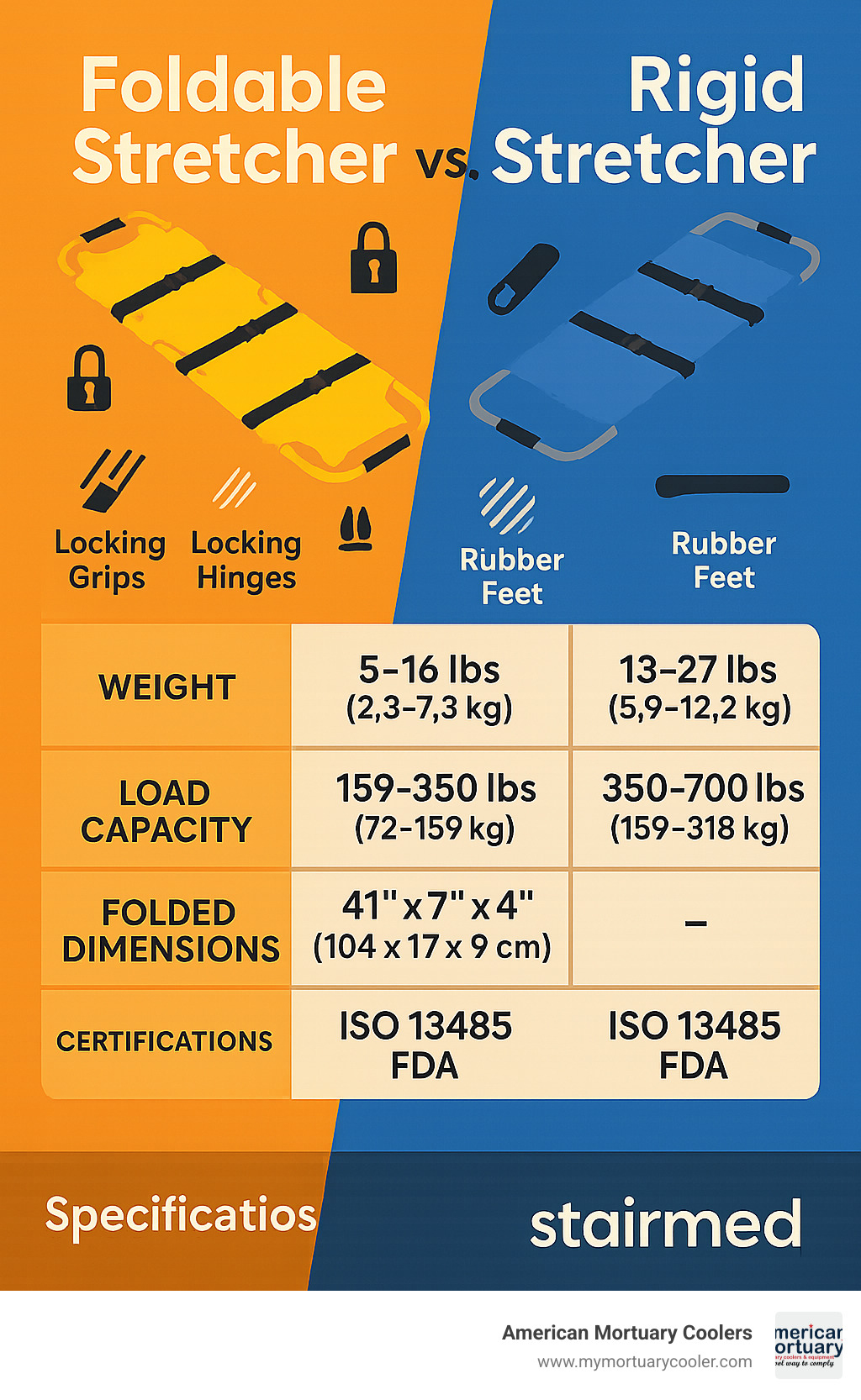
Typical Dimensions & Load Capacities
When fully deployed, most foldable stretchers stretch out to between 78-84 inches in length - accommodating everyone from the petite to the tall basketball player. Width typically falls between 20-22 inches, providing enough support for the patient while still being narrow enough to steer through standard doorways (which can be a real lifesaver in tight spaces).
Height-wise, expect your stretcher to stand about 6-13 inches off the ground when deployed. This provides enough clearance to avoid scraping along surfaces while remaining low enough for stability.
As for weight capacity, there's usually a trade-off: higher capacity models incorporate additional reinforcement, which makes them a bit heavier to carry. Standard models typically support around 350 pounds, while specialized designs like the Reeves Flexible Stretcher can handle up to 700 pounds. At American Mortuary Coolers, we can help you determine which capacity best suits your specific needs.
Relevant Certifications & Testing
Behind every quality foldable stretcher lies a battery of rigorous tests that would make an Olympic athlete wince. Before earning certifications like ISO 9001 or meeting the EU MDR 2017/745 regulations, these stretchers must prove their mettle.
Testing protocols typically include static load testing (can it hold weight without bending?), dynamic load testing (can it support weight while being moved?), drop testing (will it survive accidental falls?), and durability testing (can the folding mechanism withstand thousands of cycles?).
When selecting your foldable stretcher, ask for detailed product specification sheets that document compliance with these standards. We pride ourselves on ensuring all our stretchers meet or exceed relevant industry certifications - because when an emergency strikes, you need equipment you can trust completely.
Cleaning & Hygiene Standards
Infection control isn't just important - it's essential. The best foldable stretchers feature fluid-resistant fabrics that create a barrier against blood and bodily fluids, preventing them from penetrating the material and potentially harboring pathogens.
Many premium models go a step further with anti-bacterial coatings that actively inhibit bacterial growth between cleanings. Manufacturers typically provide specific guidelines for cleaning and disinfection using hospital-grade products that won't damage the stretcher materials.
These hygiene features ensure your foldable stretcher can be maintained in clean condition, protecting both patients and operators from cross-contamination risks. After all, the last thing you want during an emergency is to worry about the cleanliness of your equipment.
At American Mortuary Coolers, we understand that when you're dealing with patient transport or body removal, having equipment that meets these rigorous standards isn't just about compliance - it's about confidence in the tools you depend on daily.
Folding Mechanics, Maintenance & Hygiene
There's something almost magical about watching a foldable stretcher transform from a full-sized transport device into a compact package you can tuck away in a closet. This clever engineering balances strength with space-saving convenience in ways that continue to impress even seasoned medical professionals.
The folding systems vary widely across different models, but most use one of three basic approaches. Some fold lengthwise down the middle using center hinges, essentially cutting the stretcher's length in half. Others use side hinges for a width-wise fold, while the most advanced models combine both approaches for maximum compactness. What makes these systems reliable are the quick-lock bars that snap into place automatically when you unfold the stretcher – these are the unsung heroes preventing any accidental collapse when a patient is onboard.
Taking good care of your foldable stretcher isn't just about making it last longer – it's about ensuring it works flawlessly when someone's well-being depends on it. Regular checks of the hinges, locks, fabric, and handles help catch small issues before they become big problems during an emergency.
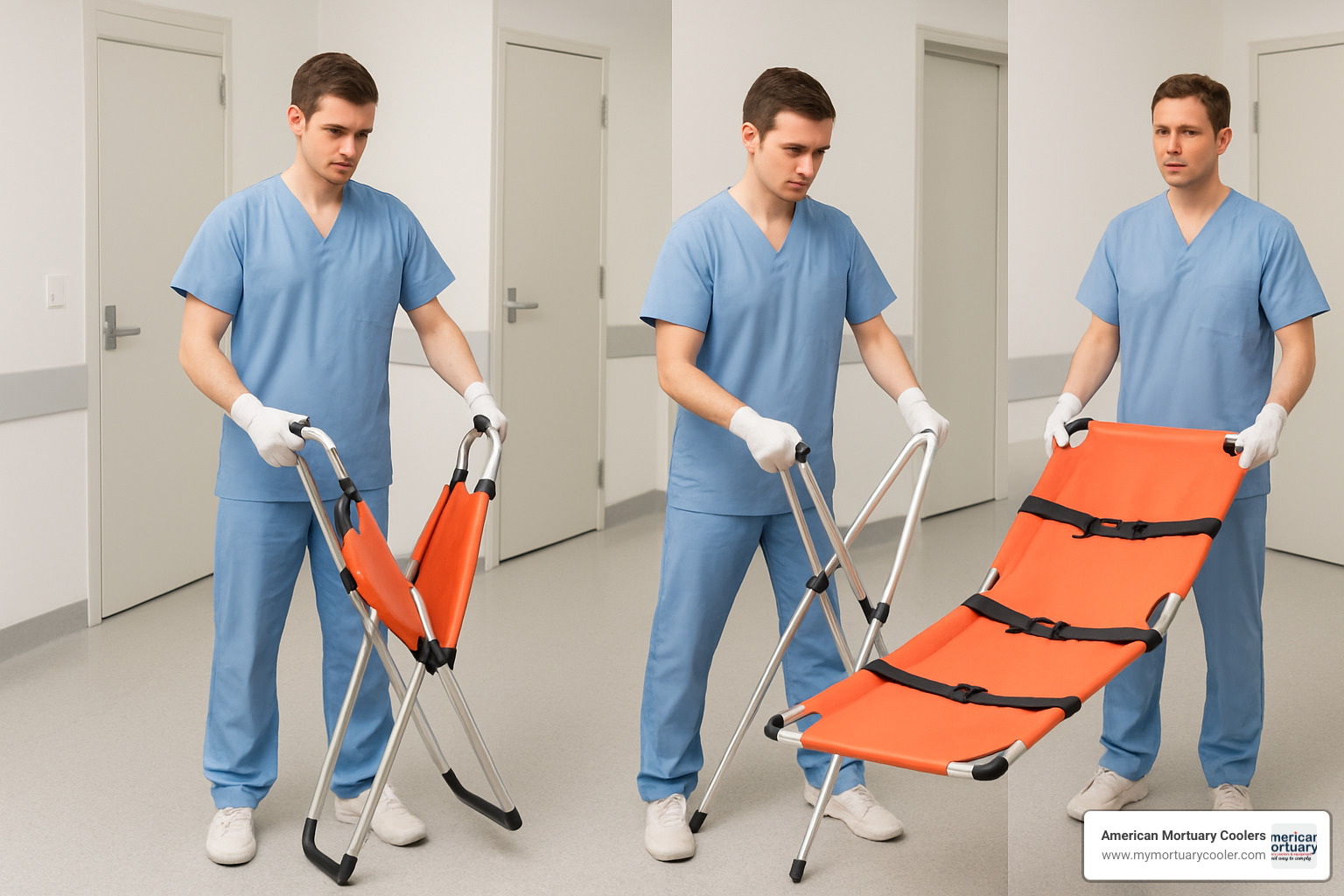
How Folding Mechanisms Work
The engineering behind a foldable stretcher is deceptively simple yet incredibly effective. At the heart of most designs are center hinges that allow the stretcher to fold lengthwise. These aren't your ordinary door hinges – they incorporate positive-locking mechanisms that click firmly into place when opened, preventing any accidental folding when the stretcher is supporting a patient.
Some of the more advanced models feature telescopic poles that extend for use and retract for storage – another clever way engineers have found to shrink the footprint without compromising function. If you've ever seen a stretcher with built-in stands, you've probably noticed the foot outriggers that fold flat against the frame when not needed but deploy quickly when it's time to use the stretcher.
The premium models that include wheels often have the most ingenious designs of all. Their wheel fold-away systems tuck the wheels into little recesses in the frame when folded, maintaining that slim profile that makes storage so much easier in crowded ambulances or equipment closets.
All these mechanical elements work together like a well-rehearsed dance, changing from full-size to compact with just a few smooth movements.
Step-by-Step Usage & Storage
Using a foldable stretcher properly involves a straightforward sequence that becomes second nature with practice:
First, unfold by taking the stretcher from its storage bag and releasing any straps. Grab opposite ends and pull apart until the frame starts to open up. Continue unfolding until you hear the satisfying clicks of all locking mechanisms engaging – always visually check that these locks are secure before trusting them with a patient's weight.
When it's time to load the patient, position the stretcher alongside them and use proper lifting techniques to transfer them onto the surface. Secure all safety belts across the patient's body – typically at chest, waist, and leg positions – adjusting them to be snug but comfortable.
For carrying, you'll need at least two people (one at each end) using the designated handles. Good communication between carriers is essential for coordinated movement, especially on stairs or uneven terrain.
After use, it's time to refold – remove the restraints, clean according to protocols, release the locking mechanisms, and fold according to the manufacturer's specific instructions. Finally, store the folded stretcher in its designated bag or container, securing any straps to keep it compact until the next use.
Following this simple workflow ensures both safety and longevity for your equipment.
Maintenance & Cleaning Tips
Keeping your foldable stretcher in top condition requires attention to both cleanliness and mechanical function.
After each use, wipe down all surfaces with simple soap and water to remove visible dirt or fluids. For more thorough disinfection, use a hospital-grade disinfectant that's approved for the stretcher materials – not all cleaning products are suitable for medical equipment, and using the wrong one could damage the fabric or frame. Pay extra attention to areas that directly contact patients, and always let the stretcher dry completely before folding it away to prevent mildew.
The mechanical parts need love too. Regularly check all hinges and locking mechanisms for signs of wear or damage. A small amount of silicone-based lubricant (according to manufacturer recommendations) keeps hinges working smoothly. While you're at it, verify that all fasteners remain tight and test the locking mechanisms to ensure they engage properly – that distinctive "click" should be clear and positive.
Don't forget about the fabric bed itself. Look for tears, punctures, or thinning material, especially at stress points. Check that the stitching remains intact and that all attachment points between the fabric and frame are secure. If you spot damage, don't wait – replace the fabric according to manufacturer guidelines before it fails during use.
For more comprehensive guidance on maintaining all types of lifting equipment, our guide on mortuary lifting equipment upkeep offers additional detailed information that applies to foldable stretchers as well.
Applications & Real-World Case Studies
The beauty of a foldable stretcher lies in its remarkable versatility. These portable transport devices have found their way into countless settings where moving patients or deceased individuals safely is essential. Their ability to compact for storage yet deploy quickly when needed makes them invaluable across diverse environments.
Emergency medical teams love foldable stretchers because they solve problems that standard equipment can't. Imagine trying to steer a narrow apartment stairwell with a full-sized gurney – nearly impossible! But a foldable stretcher slides through with ease, potentially saving precious minutes during a cardiac emergency.
Hospitals keep these compact devices on hand for situations where standard transport equipment won't fit or when they need backup options during busy periods. Sports teams position them strategically around venues, ready to respond to injuries with minimal delay. And when disaster strikes, the ability to store multiple foldable stretchers in limited space becomes invaluable for mass casualty response.
In our work at American Mortuary Coolers, we've seen funeral homes rely heavily on foldable stretchers for removing deceased individuals from challenging locations. Their slim profile and lightweight design make them perfect for navigating tight spaces in homes where standard mortuary cots simply won't fit.
Emergency Medical Services (EMS)
EMS professionals face unique challenges every day that make foldable stretchers essential equipment in their arsenal.
Those tight stairwells I mentioned? They're a daily reality for paramedics working in older apartment buildings or homes with narrow passages. One Tennessee paramedic told us about responding to a heart attack victim on the third floor of a building with a spiral staircase: "There was absolutely no way our regular gurney would make that turn. The foldable stretcher was literally the difference between a rapid transport and what could have been a fatal delay."
During mass-casualty incidents, ambulance services must maximize their transport capability with limited resources. Foldable stretchers allow teams to carry multiple transport devices in the same space that would normally accommodate just one or two standard gurneys. This multiplication of capacity can be lifesaving when minutes count.
Even when wheeled gurneys are the primary transport method, foldable stretchers often serve as a critical bridge. Patients can be moved from hard-to-reach locations to areas where the wheeled gurney waits, creating a seamless transport chain that prioritizes both patient comfort and responder safety.
Hospitals, Sports & Events
Hospital emergency departments keep foldable stretchers ready for those moments when patient volume spikes or unusual transport challenges arise. Their space-efficient storage means they don't take up valuable floor space until the moment they're needed.
Athletic trainers and sports medicine teams have acceptd these portable devices with particular enthusiasm. When a player goes down with a potential spinal injury, the medical team needs to reach them quickly with proper equipment. A sports physician from a professional football team in Dallas shared his experience: "We position four foldable stretchers around our stadium for immediate access. Last season, when our safety took a dangerous hit, we had him immobilized and off the field in under two minutes. That rapid response is only possible because these stretchers are ready exactly where we need them."
Marathon medical tents represent another perfect application. These temporary medical facilities need to balance treatment capacity with limited setup space. Foldable stretchers allow organizers to deploy exactly the number of transport devices needed based on patient volume, scaling up or down as conditions demand.
Disaster Response, Military & Veterinary
When conditions turn extreme, equipment must be both durable and portable – precisely the combination foldable stretchers deliver.
Search and rescue teams operating in wilderness areas or collapsed structures can't afford to be weighed down by bulky equipment. The lightweight design of a foldable stretcher allows them to carry the device to the patient location, even over difficult terrain or through tight spaces in debris fields.
Military medics operating in forward positions face similar challenges but with the added complexity of potential enemy contact. The ability to carry a foldable stretcher in its compact form during patrols and deploy it only when needed helps maintain mobility while ensuring transport capability when casualties occur.
The veterinary world has also found value in specialized foldable stretchers designed for animal patients. These modified designs accommodate quadruped body shapes while providing the same benefits of portability and compact storage. Animal rescue organizations working during disasters particularly value the Reeves flexible stretcher, which combines exceptional durability with a 700-pound capacity – perfect for larger animals like horses or livestock.
Testimonials & Success Stories
The true value of foldable stretchers comes alive through the experiences of the professionals who rely on them daily.
An Atlanta-based paramedic supervisor shared a particularly powerful story: "We responded to a bus accident with 12 injured passengers. Our ambulances can only carry two standard gurneys each, but we transported eight additional patients using our foldable stretchers. That capability meant everyone reached the hospital within the golden hour for trauma care, potentially saving lives that might have been lost waiting for additional ambulances."
The sports world offers equally compelling testimonials. One sports medicine director told us about a championship football game where their quarterback took a devastating hit: "He couldn't move his legs, and we suspected a spinal injury. Our foldable stretcher with head immobilizers allowed us to transport him from midfield to our medical facility without compromising his spine alignment. The doctors later confirmed that our careful transport prevented what could have been permanent nerve damage."
Perhaps most moving was the experience shared by a disaster response coordinator following a devastating tornado: "We had to evacuate a nursing home with no power and limited access roads. The foldable stretchers allowed us to move 24 non-ambulatory residents through narrow hallways and down stairs that would have been impossible with standard equipment. Every single resident was evacuated safely, despite incredibly challenging conditions."
These real-world experiences aren't just testimonials – they're powerful reminders of why foldable stretchers remain essential equipment across diverse emergency and medical settings. Their ability to solve transport challenges in unpredictable environments makes them truly invaluable tools for saving lives.
Buying Guide: Choosing the Best Foldable Stretcher
Finding the perfect foldable stretcher feels a bit like shopping for a good pair of shoes - what works beautifully for one person might be completely wrong for another. With options ranging from basic models to sophisticated systems with all the bells and whistles, making the right choice requires understanding what truly matters for your specific needs.
I've helped countless funeral homes across America - from small family operations in Tennessee to large metropolitan facilities in California - find the perfect balance between functionality, durability, and value. The key is looking beyond today's requirements to anticipate tomorrow's needs. A stretcher that seems adequate now might become a limitation as your operations evolve.
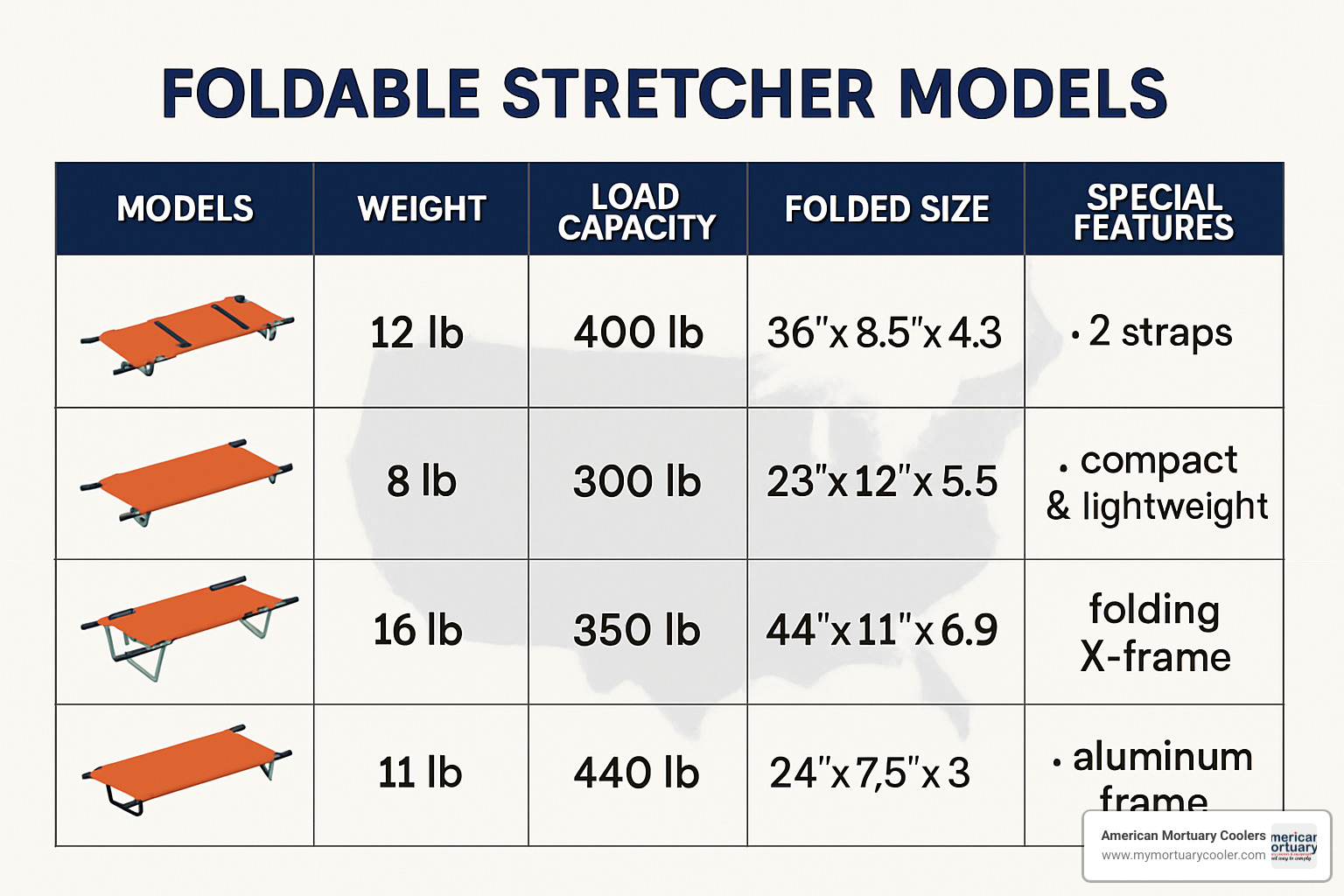
Key Decision Factors
When you're evaluating foldable stretchers, several factors should guide your decision-making process. Think of these as your non-negotiables:
The eternal balance between weight and capacity represents perhaps the most important tradeoff. Lighter models (typically 5-8 pounds) are easier to carry when folded but generally support less weight. Heavier models (10-16 pounds) can handle larger individuals but require more strength to transport when not in use. Consider who will be using the stretcher most frequently and their physical capabilities.
Material quality directly impacts how long your investment will last. Look for anodized aluminum frames that resist corrosion even in challenging environments. The fabric should feature double-stitching at stress points and reinforced attachment points where it connects to the frame. If you'll be using the stretcher outdoors frequently, UV-resistant materials will prevent premature degradation. For infection control (particularly important in mortuary settings), fluid-resistant coatings are essential.
Your available storage space should determine which folding style makes the most sense. Length-fold models work beautifully in tall, narrow cabinets, while width-fold designs fit better in shallow compartments. If space is at an absolute premium, quad-fold options offer maximum compactness, though they typically involve slightly more complex deployment.
Consider whether additional features justify their cost for your specific application. Integrated wheels can significantly reduce carrier fatigue during longer transports. Head immobilizers become essential if you might encounter cases with potential spinal injuries. A quality carrying bag isn't just convenient - it protects your investment during storage and transport. Extra restraint straps improve security, particularly important when navigating stairs or uneven terrain.
Finally, pay attention to the warranty offered. Quality manufacturers typically provide 1-3 years of coverage for standard use, reflecting their confidence in their product's durability. If you anticipate high-volume usage, ask about extended warranty options.
Price Range & Cost Drivers
Understanding what drives the price differences between foldable stretchers helps you determine whether premium features justify their cost in your specific situation.
Standard models typically range from $70-$130, offering aluminum frames with PVC-coated polyester beds. These workhorses of the industry usually fold in a single direction, support around 350 pounds, include 2-3 patient restraint straps, and come with a basic carrying bag. For many applications, these models provide excellent value without unnecessary complications.
Moving up to premium models in the $150-$300 range brings additional features that might be worth the investment depending on your needs. These often incorporate multi-directional folding for more compact storage, higher weight capacities exceeding 500 pounds, integrated wheels or stands for easier handling, improved restraint systems, and more durable carrying cases. If you're handling larger individuals or working in challenging environments, these upgrades often pay for themselves through improved functionality and durability.
At the top end, specialized designs exceeding $300 typically feature wheeled transport systems that allow single-operator movement in certain situations, adjustable backrests for patient comfort, radiolucent materials compatible with imaging equipment, or military-grade construction for extreme environments. While these features command a premium price, they solve specific challenges that standard models simply can't address.
For organizations purchasing multiple units, quantity discounts often bring premium models within reach of more modest budgets. Additionally, stretchers certified to higher standards (FDA, CE, ISO) might cost more initially but frequently offer superior durability that reduces long-term replacement costs. The cheapest option rarely offers the best value over the life of the product.
Top Brands & Models to Consider
After years of helping funeral homes select transport equipment, I've seen certain manufacturers consistently deliver quality and innovation in the foldable stretcher market:
The FERNO 108-A has earned its reputation as a standard-bearer in the industry. Its heavy-duty aluminum poles feature non-slip handgrips that maintain security even in wet conditions. The vinyl-coated nylon cover resists fluids and stains - a crucial feature in mortuary settings. With lengthwise folding for compact storage, a generous 350-pound capacity, and a reasonable 12-pound unit weight, it's trusted by EMS services nationwide for good reason.
The LINE2design Emergency Medical Folding Stretcher offers exceptional value for organizations watching their budget. Its bright orange PVC vinyl construction sheds water and resists tears even with frequent use. The aluminum alloy frame strikes an excellent balance between strength and weight, while its compact folded dimensions (43" × 8.5" × 4") make storage simple. It includes a zippered carrying bag with a comfortable strap, and the fixed feet provide welcome stability during patient loading.
For specialized applications requiring exceptional capacity, the Reeves Flexible Stretcher stands apart. With an impressive 700-pound capacity, its lightweight polyester construction supported by removable hardwood slats offers flexibility without sacrificing strength. The fluid-resistant, vinyl-coated fabric makes cleaning straightforward, while 10 strategically placed handholds provide optimal carrying positions for multiple handlers. When folded, its compact profile minimizes storage requirements.
The Botuwase Foldable Stretcher deserves attention for its innovative dual-direction folding capability. By folding both vertically and horizontally, it achieves ultra-compact storage dimensions that work even in the tightest spaces. Despite weighing just 5kg, it supports an impressive 159kg capacity. The anti-bacterial, stain-resistant PVC-coated polyester bed offers practical benefits in any setting, while dual safety belts with quick-release buckles ensure secure transport. Rubber handles provide a secure grip even during challenging carries.
In mortuary settings specifically, the Mobi FRS-350 has gained popularity for its thoughtful specialized features. The built-in zipper pouch provides convenient storage for tools or personal effects during transport. Fold-away wheels and drop-down legs offer multi-mode transport options depending on the situation. The fluid-resistant, waterproof materials are ideal for mortuary use, while the 350-pound capacity accommodates most needs. With FDA, CE, and ISO 9001 certification, you can trust its performance in sensitive situations.
Frequently Asked Questions About Foldable Stretchers
What is the load capacity of a foldable stretcher?
Most standard foldable stretchers comfortably support 350 pounds (159 kg), which covers the vast majority of transport needs. If you regularly handle larger individuals, specialized bariatric models can support up to 700 pounds (318 kg).
I always recommend selecting a model with capacity that exceeds your anticipated maximum load by at least 20%. This buffer provides peace of mind and extends equipment life by reducing stress on components. I've seen the consequences when funeral homes exceed rated capacities - bent frames, torn fabric, and worst of all, compromised dignity for the deceased and potential injury to staff. The right equipment prevents these unfortunate situations.
How do I clean and disinfect a foldable stretcher?
Proper cleaning isn't just about appearance - it's essential for infection control and equipment longevity. After each use, start with physical cleaning using mild detergent and water to remove visible contamination. This step is crucial - disinfectants work much more effectively on clean surfaces.
Next, apply a hospital-grade disinfectant approved for your stretcher's specific materials. Pay extra attention to high-touch surfaces like handles and restraint buckles. Allow the disinfectant to remain in contact with surfaces for the full time specified by the manufacturer - this "dwell time" is critical for effective pathogen elimination.
For hinges and mechanical components, a silicone-based lubricant applied after cleaning keeps everything operating smoothly. Avoid petroleum-based products that might degrade certain materials or attract dirt like a magnet.
Always allow your foldable stretcher to dry completely before folding and storing. Moisture trapped in folded fabric creates ideal conditions for mold and mildew growth, which can deteriorate materials and create unpleasant odors.
Are foldable stretchers as safe as rigid models?
This question comes up frequently, and the answer is reassuring: when properly designed, manufactured, and used, foldable stretchers provide safety comparable to rigid models for most applications.
Quality manufacturers subject their designs to rigorous static and dynamic load testing that verifies capacity under various real-world conditions. The restraint systems on modern stretchers secure patients effectively during transport, preventing movement or falls even when navigating stairs or uneven terrain.
Proper training makes an enormous difference in safety outcomes. Users should understand the correct unfolding procedures, know how to verify that locking mechanisms are fully engaged, and employ appropriate carrying techniques. At American Mortuary Coolers, we emphasize that the best equipment is only as good as the training behind it.
For situations involving suspected spinal injuries, specialized immobilization equipment should supplement basic foldable stretchers. Many models can accommodate backboards or other rigid supports when full immobilization becomes necessary.
The bottom line? Equipment selection should always prioritize safety for both the transported individual and the operators. The right foldable stretcher provides this security while offering the practical benefits of compact storage and portability that make it such a valuable tool across so many settings.
Conclusion
The humble foldable stretcher represents a remarkable balance of engineering ingenuity, practical functionality, and space-efficient design. These versatile transport devices have become essential equipment across diverse settings - from busy emergency departments to remote disaster zones, from sideline sports medicine to dignified funeral services.
When selecting a foldable stretcher, matching specifications to your specific needs is crucial. Think about who you'll typically be transporting - their average weight and size. Consider your available storage space - is it tall and narrow or short and wide? Picture the environments where you'll deploy the stretcher - smooth hospital hallways or rugged outdoor terrain? And be honest about usage frequency - daily deployments demand different durability than occasional use. These practical considerations will naturally guide you toward models with appropriate folding mechanisms, materials, and features.
Safety should always remain your primary consideration. Any foldable stretcher worth purchasing meets relevant certifications, incorporates adequate patient restraint systems, and features reliable locking mechanisms that prevent accidental folding during use. But remember - even the best equipment requires proper handling. Training for all operators dramatically improves safety by ensuring correct deployment, proper patient securing, and appropriate carrying techniques.
Durability represents another critical factor, particularly for organizations using stretchers frequently. While quality materials and construction may come with higher price tags, they typically deliver superior longevity and reliability. The difference between an economy model and a professional-grade foldable stretcher becomes strikingly evident after months or years of regular service.
At American Mortuary Coolers, we understand that transport equipment represents a significant investment for funeral homes, emergency services, and healthcare facilities. Our team specializes in helping clients select equipment that balances immediate budget constraints with long-term performance requirements. We serve clients nationwide, from Tennessee to California, with the same dedication to finding the right solution for each unique situation.
For those interested in exploring additional transport solutions beyond foldable stretchers, we invite you to review our guide on Efficient Transport with Church Trucks and More.
As a nationwide provider of customized, certified equipment, American Mortuary Coolers delivers the expertise, product selection, and support needed to make confident equipment decisions. Whether you're equipping a new facility or upgrading existing transport capabilities, our team stands ready to help you select the ideal foldable stretcher for your specific requirements.
Choose confidently, prioritize safety and durability, and stay prepared for whatever transport challenges you may face.

















